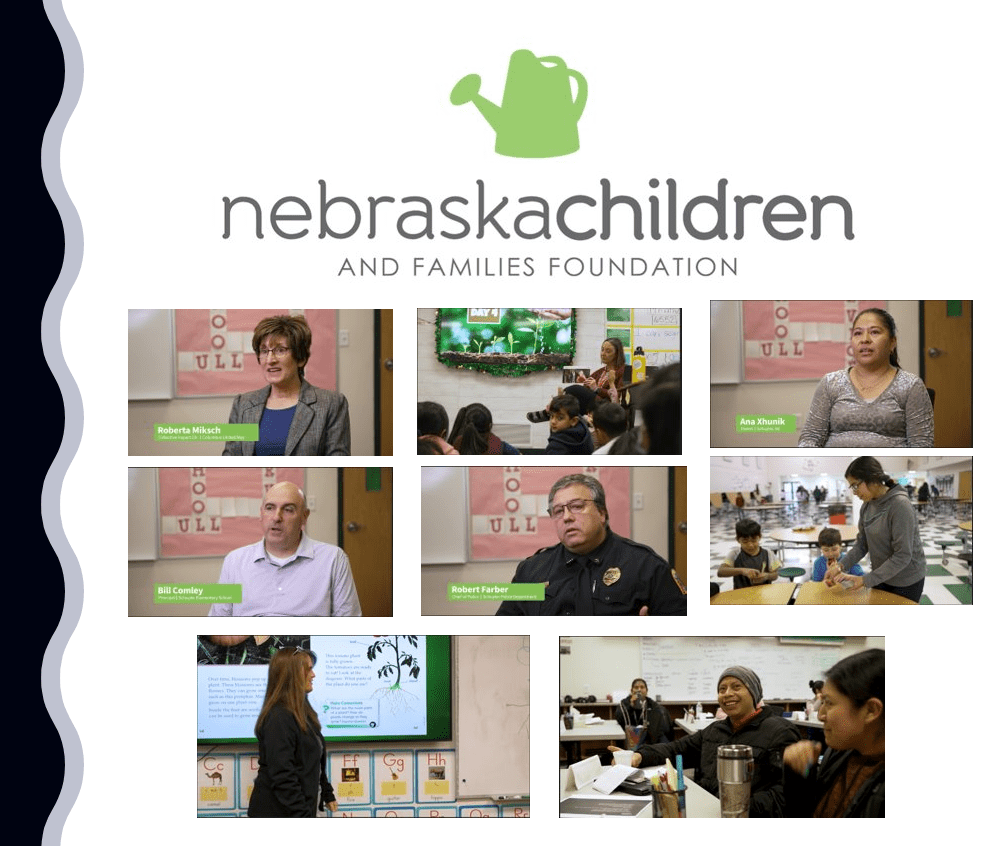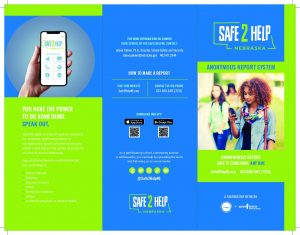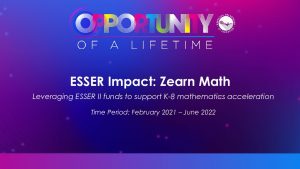ESSER Impact Story
This page will elevate best practices, partnerships, and early impacts from ESSER statewide set aside funds.
Focus On Acceleration
How did Partnering with Instruction Partners affect your work?
Kelly Georgius – ESU 2/Northeast Elementary at Lyons
The math NSCAS data from SY20–21 to SY21–22 improved significantly. Student proficiency in math went from 36% to 58%. This was a really good opportunity to pair with another math person, and talk and learn from each other, and just really dive into what’s happening.
Jen Madison and Tara Gossman – ESU 4/Pawnee City Schools
Seeing teachers make connections with each other and the curriculum through grades [kept] the district moving forward with good conversations.
Alison Smith – ESU 16/Sutherland
Student proficiency went from 58% in SY20–21 to 63% in SY21–22. In addition, the tweaked inclusion model for students with special needs had all students learning HQIM grade level standards together. This project has provided a roadmap to guide successful implementation of HQIM while building leadership capacity. As a professional development provider, coming alongside the teachers and leaders has been critical with the process of the math acceleration project so that true implementation of HQIM occurs and all, and I mean all, students grow in their learning.
Jess Bland – Superintendent of Oakland-Craig
In what ways has Canvas use benefited your school or district’s staff?
Great way to organize everything for students and staff; rather than using a variety of learning management systems and having students log in to multiple sites, we’ve been able to use single sign-on with their Gmail accounts so it is quick and easy for kids and staff; All courses are loaded in Canvas from PowerSchool as our students so the process is much quicker than adding them individually; simplified things for parents, staff, etc.; grading syncs directly to PowerSchool
In what ways has Canvas benefited your school or district’s students?
Able to create one common home page so kids know where to go for anything they need in all classes; Easy to sign in to and access; great way to share announcements; we also use it for activities so coaches can communicate with kids via the announcement’s toolbar; easy to access if they are out of school.
How has Canvas transformed learning in your school or district?
We constantly have kids out of our district, not necessarily because they are sick but because they are highly involved. Canvas allows them to participate regardless of being gone and they are able to stay on top of their schoolwork, replay instructional videos, etc. so they are ready to go when they return to school. Created more time for teachers to focus on instruction rather than grading as many of the assignments can be automatically graded in Canvas and grades can be sent directly to PowerSchool. From the administrative perspective it has saved me a ton of time as I house everything in Canvas. I have a page for my BOE, CIP, Crisis Team, all staff, etc. and every document they could need or want is housed there. It saves me time from people asking where they can find things because they know my response will be to go to Canvas. Also, we transitioned to flipped staff meetings when I served as the elementary principal. I sent staff videos of all the informational items I needed them to know, and they would watch it whenever it was convenient for them. We then met only to cover items that needed to be discussed, which they loved because they were never wasting time in meetings as the meetings, they were at were always engaging and required them to give input and feedback.
Do you feel Canvas has improved learning outcomes for your students, if so, how?
I’m not sure we’ve used Canvas in a way to improve learning outcomes but for sure it has improved the access our kids have, saves everyone time, and simplifies things. We just haven’t used it to its full potential like we’d like.
Why would you recommend a school or district adopt Canvas?
Great support team, user friendly, allows you to share across the district or world in a simple way through the Commons, so many integration tools, we feel it is best to simplify things for kids and parents focusing on only one Learning Management System rather than many; this is what they are using at the post-secondary level across Nebraska so students are familiar with it if they choose to go to college.
They can see what teachers expect what the assignments are, grades, etc. Parents must contact teachers less because they can see exactly what is happening in class from day to day and can see what their students have submitted, grades, etc. We also use it for announcements on occasion, but we haven’t mastered this.
In what ways has Canvas improved communication with students and parents, if any?
If you need anyone to support your request to attend/speak from the school district perspective at the meeting, let me know. I’m happy to help. I’m not sure of my availability or when the meeting is but if I’m free I’m more than willing to help in any way I can.
Josh Snyder – Director of Learning at Wahoo
In what ways has Canvas use benefited your school or district’s staff?
The use of Canvas within our district has helped create consistency with a single learning management system (LMS). A single LMS has helped the district provide support and professional development in an easier fashion than when we had multiple platforms across the district. Teachers use the Canvas platform to create and engage students within discussion groups, house, and share learning resources, and create both formative and summative assignments and assessments. We have also used the Canvas platform to streamline how our building leaders share information and house important documents in a consistent manner. All team notes from Professional Learning Community (PLC) meetings are linked within Canvas.
In what ways has Canvas benefited your school or district’s students?
The use of Canvas within our district has helped create consistency with a single learning management system (LMS). A single LMS has helped the district provide support and troubleshooting in an easier fashion than when we had multiple platforms across the district. The use of Canvas has improved the ability of our staff to share information with our students in a timely and efficient manner. During the pandemic, we were able to maintain contact with students in a remote setting and keep students moving forward in their learning. The system allows students to interact with their content outside of a lecture first manner. Students are encouraged to communicate with one another via the discussion forums and can very easily submit completed work to their teacher whether they are at school, home, or out of state. Many of our students who transition to post-secondary schooling express that the use of Canvas for them in high school has greatly improved their acclimation to college (many of the local colleges utilize Canvas).
How has Canvas transformed learning in your school or district?
Canvas has helped promote the idea that learning does not need to stop when students leave the building. We have a high number of students who are highly engaged in extracurricular activities (band, choir, sports, FBLA, etc.) and the use of Canvas has helped these students stay connected with the learning that is taking place within the classroom when they miss school for these activities. We also have teachers who are using the platform to post video clips of lectures or important content, so students aren’t missing this important information.
Do you feel Canvas has improved learning outcomes for your students, if so, how?
It’s very hard for me to say that the implementation of Canvas, by itself, has directly improved learning outcomes. I do know that it has created consistency within some of the systems that allow us to deliver content to students and it has made access to materials a lot easier for some of our most active students and those who may be in an alternate location for a variety of reasons.
Why would you recommend a school or district adopt Canvas?
I would recommend that a school or district take the time to identify what their specifics needs are and what goals they would like to accomplish with a learning management system. Take the time to research what Canvas offers and whether it meets your needs. I would never recommend that someone adopt Canvas without going through that process.
In what ways has Canvas improved communication with students and parents, if any?
Each year we work to set our families up with an “Observer” account within Canvas. This allows families to see exactly what their son or daughter may have for assignments and the timeline associated with each assignment. The more involved parents are in the learning process, the greater the success of our students. The “Observer” setting has made it a lot easier for our families to “see” what students are learning about in class.
Mental Health ESSER Funded Program Testimonials
Amie Albrecht - School Counselor at Wilber-Clatonia Public Schools
We have been able to put a lot of new incentives in place to help our students and staff at Wilber-Clatonia. This year we have focused on gather information, sorting what we currently have and allocating time to figuring out what works best based on needs and age groups. We have been able to bring in presentations, create flowcharts and visuals, and implement some services that we otherwise wouldn’t have had access to. We look forward to continuing in this grant and doing more wonderful things for the students and staff at Wilber-Clatonia.
Michele Rayburn - Director of Student Services at Educational Service Unit 6
The ESSER funds increased the capacity of our service unit to support the mental health of students and staff in our school districts. Specifically, the funds provided training to create a sustainable improvement process by focusing on the foundations of an effective system of support. The funds were also used to support specific components of district action plans.
Sara Gentry - School Social Worker at ESU 16
These funds allowed us to use a comprehensive tool to evaluate our mental health program in depth. During our mental health institute, we established that one central theme that was we as an ESU are missing the mark with Adult SEL and all agreed that this would be the initial focus for our schools leading into more comprehensive planning and redefining of our SEL/Behavioral MTSS process for students. It was rewarding to see the district administrators identify that their staff members are struggling with compassion fatigue and burn out and that they need to address the wellbeing of their teachers while also working towards developing consistent evidence-based interventions for Tier 2 students.
Haley Hoarty - 7-12 Counselor at Fillmore Central Public Schools
Upon entering this project with ESU 6, I hoped to learn about the role mental health is playing for students in our school building. As a staff, we knew we were saying more concerns, but I was hoping to find some solid data showing its impact on learning; furthermore, I was hoping to learn some strategies or idea to help facilitate social emotional growth in our students. This project has been one of the most impactful initiatives I have been a part of in my educational career. ESU 6 has done a great job facilitating this project and has really encouraged our mental health team, as well as our whole staff, to take a closer look at our students social and emotional wellbeing. They have provided resources for trauma informed care, resilience, staff wellness, and a multitude of others which has our team at Fillmore Central excited to continue in this work. I think all students and staff at Fillmore Central will feel a positive lasting effect from our work with the Mental Health Project. We are beyond grateful to ESU 6.
Jen Pollock - School Mental Health Program Coordinator at ESU #3
The utilization of these ESSER funds has allowed us to better, and more efficiently support our districts in the development and enhancement of their current systematic practices in a meaningful way. We have had opportunity to provide technical assistance, not only in a broad way to our School Mental Health Workshop participants, but also on an individualized level. Our participating districts are increasing their efficiency and effectiveness in the implementation of their comprehensive school mental health systems, which in turn, allows for increased student success- both academically and emotionally!
Geraldine Erickson - Administrator at ESU 17
Schools in our service area are utilizing ESSER funds to support school-wide mental health efforts. We have been able to improve our services to schools by increasing our focus on multi-tiered systems of support, consultation, social-emotional skill building, crisis response, and individual counseling. Schools have prioritized referral and mental health-related processes for integration into their existing systems.
Jessica Shepard - School Psychologist/Special Education Coordinator at ESU 9
This program has given funding to mental health needs in a rural area of Nebraska that otherwise would not have had access to this kind of funding. It allowed school teams to learn from each other, problem-solve hurdles, and brainstorm solutions to problems they all face. Regular gatherings with teams answered questions for schools that they previously had but didn’t necessarily know where to go or where to start to support those needs. I believe that schools in our area became more confident in working with mental health needs.
Roberta Miksch - Community & Family Partnership Collective Impact Director at Columbus Area United Way
Hiring a FSCS Coordinator to be embedded within the school to focus on the “whole child” who is surrounded by the family and living within the larger community. With an FSCS Coordinator in place, the expectations with this project included expanding the Teammates program to include increasing the number of mentors to be paired with mentees, coordinating, and conducting the mobile food pantry once a month, and Family Literacy which is conducted two mornings a week at the school. In addition, Community & Family Partnership (CFP) expected this work to be a segue into determining root causes of barriers families were facing such as barriers to getting their children to school on time or at all, barriers to healthcare access or receiving services, etc. as well as determining what services were needed and how CFP could begin to close the gaps discovered. Through this work, CFP would develop and nurture new and existing relationships with the community (Chamber, businesses, housing, food pantries, etc.). One of the successes of this project was in coordinating and conducting a vision clinic for first and second graders at the school in partnership with the Nebraska Foundation for Children’s Vision (NFCV). Access to medical, dental or vision care is a challenge for many families due to socioeconomic status and barriers. After being assessed for their vision by the NFCV team, thirty-three students received glasses to assist with their vision and, ultimately, ability to see the whiteboard/chalkboard, in the classroom. The ESSER funds provided CFP/CAUW with an avenue to place a staff person directly into the Schuyler Elementary School to focus on the expectations/goals of the project. Additionally, this funding allowed CFP/CAUW the opportunity to focus on the four pillars of comprehensive community schools. There isn’t anyone else in the school or community working specifically in the schools to directly impact the students, parents and community in the way that it does.
Odessa Cooley - Full-Service Community School Coordinator at Dakota City Elementary School
Our major project for the second year of the Full-Service Community School funding was our Vision Clinic. In Oct. 2022, Dakota City worked with Nebraska Foundation for Children’s Vision and Drs. Kincaid, Fett & Kincaid to provide an on-site vision clinic at Dakota City Elementary School. Our school nurses provided students results of our in-house health screening, and we focused on those who failed the vision portion of the screening. We reached out to the parents to receive permission for an in-depth eye exam at no cost to the family and a pair of eyeglasses for the student if needed. We recruited volunteers from our local community, nursing students, and staff from Drs. Kincaid, Fett & Kincaid optometrists in South Sioux City. In our one-day clinic, we were able to screen around 60 students identified by our school health screening, and of those, 45 students needed eyeglasses. Following the success of our on-site vision clinic, the school district wished to be able to reach more students identified by our health screenings. We are now in communication with the district administration and Drs. Kincaid, Fett & Kincaid optometrists tp provide appointments during the school day where children can be seen at their local office for an exam and receive eyeglasses as needed. The optometrist’s office will work with the family’s vision insurance to provide the services. Suppose the family does not have vision insurance. In that case, there will be partnerships with the local Optimist Club and other organizations to make sure the child can receive a pair of glasses. We are working with the NE Foundation for Children’s Vision and our local optometrists to provide resources and education to the parents on the necessity for vision check-ups, glasses, and how it may impact their child’s learning.
Ronelle Jackson - LIMHP at ESU 7
Our ESU chose to integrate common language from the MTSS framework to help districts better understand mental health in tiered system. The funds prioritized the development of a mental health system within districts we serve by encouraging awareness, providing education, and allowing time for collaboration.





